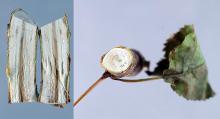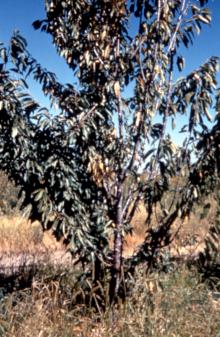See:
Maple (Acer spp.) - Verticillium Wilt
Cause Verticillium dahliae, a soilborne fungus that may remain viable in soil for years. The fungus forms microsclerotia within infected tissues. Once in the soil they germinate and infect roots. The fungus grows into the xylem where it colonizes the plant through mycelial growth and conidial production. Fluid movement in the xylem passively transports the conidia. Once in the xylem, this fungus partially blocks water movement and produces toxins that result in wilt symptoms. The disease usually affects young trees coming into bearing but may be found on older trees. Verticillium wilt affects numerous plants including apricot, lambsquarters, nightshade, peach, pepper, phlox, potato, raspberry, shepherd's purse, strawberry, and tomato. Plant-parasitic nematodes also can increase disease incidence and severity. Abundant irrigation, high nitrogen fertility, and cultivation that injures roots have also been associated with higher disease incidence.
Symptoms Some lower leaves yellow, and later so do higher leaves; often, twigs and branches also wilt and die. East of the Cascade Range, leaves may turn reddish-orange. Spurs and twigs may die so rapidly that leaves remain attached. Leaves of current-season shoots and older wood may drop off or be less numerous than on healthy trees, giving trees an open or bare appearance. Some branches may appear healthy while others wilt and die. Discoloration (brown-red) in sapwood of some diseased branches or trunks can be observed by cutting into the branches with a pocket knife. In cross section, the xylem (wood) may be discolored in arcs or rings.
Sampling A preplant soil test for propagules of this fungus will aid in site selection. Nurseries may wish to test individual core samples to determine the distribution in a particular field. The presence of any microsclerotia in the soil should be interpreted as a potential disease risk.
Cultural control Trees have recovered after proper cultural care.
- Do not plant orchards in soils where Verticillium-susceptible crops (see above) have been grown previously.
- Do not interplant with Verticillium-susceptible crops.
- Control weeds.
- Avoid excessive irrigation, severe pruning, or other measures that promote succulent growth.
- Research on control of Verticillium wilt in other crops indicates that nitrogenous fertilizers should be used at minimum rates-sufficient only to provide normal growth. One test in British Columbia showed that reducing ammonium nitrate from 6 to 2 lb per cherry tree did not reduce terminal growth but did allow trees to recover from the disease.
- Remove and destroy symptomatic or dead branches preferably before leaves fall and thus before new inoculum gets incorporated into the ground.
- Clean pruning equipment after use.
Reference Cirulli, M., Amenduni, M., and Paplomatas, E. J. 1998. Stone Fruits. in Hiemstra, J. A. and Harris, D. C. (ed) A compendium of Verticillium wilts in tree species. CPRO. ISBN 90-73771-25-0




